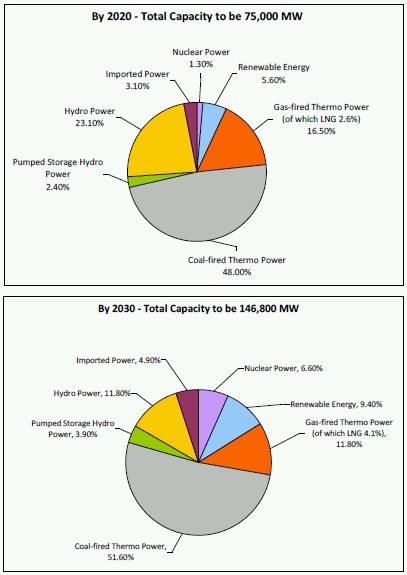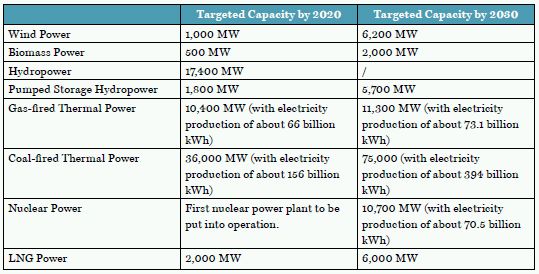Originally published 1 September 2011
Keywords: national power development plan, Power Master Plan VII, Vietnam, energy, power market, renewable energy,
The Prime Minister of Vietnam approved the national power development plan for the 2011-2020 period with the vision to 2030 (the "Power Master Plan VII") on 21 July 2011 under his Decision No. 1208/QD-TTg. The Power Master Plan VII puts strong emphasis on energy security, energy efficiency, renewable energy development and power market liberalisation. It also aims to address various problems encountered during the implementation of the previous Power Master Plan VI.
The Power Master Plan VII sets out six key directions and four specific targets for Vietnam's power development in the next 20 years:
Six Key Directions
- Integrate the development of the power sector into the socio-economic development strategy of Vietnam and ensure sufficient supply of electricity for the national economy and social life.
- Combine the efficient use of domestic energy resources with the reasonable import of electricity and fuels and diversify the primary energy resources for power generation and fuel conservation and ensure energy security for future.
- Improve the quality of electricity and electricity services step by step and adjust the electricity tariffs according to the market mechanism to encourage investment in power sector and efficient use of electricity.
- Develop the power sector in parallel with the protection of natural resources and the eco-environment to ensure sustainable development of the country.
- Create a competitive power market by diversifying the form of investment and trading of electricity. The State shall hold monopoly only in the power transmission network in order to ensure security of the national energy system.
- Develop the power sector based on reasonable and efficient use of primary energy resources in each region and continue the promotion of rural electrification to ensure sufficient, continuous and safe supply of electricity to the whole country.
Four Specific Targets:
- Increase the aggregate output of imported and produced electricity from 194-210 billion kWh by 2015 to 330-362 billion kWh by 2020 and 695-834 billion kWh by 2030.
- Give priority to the development of power generation from the renewable energy so that the proportion of electricity generated from the renewable energy will be increased from the present 3.5% of the total electricity production to 4.5% in 2020 and 6% in 2030.
- Reduce the average energy elasticity ratio (the ratio between the growth rate of energy consumption and the growth rate of GDP in the same period) from the current 2.0 to 1.5 in 2015 and 1.0 in 2020.
- Promote the rural electrification program in rural, mountainous and island areas so that most of the rural households will have access to the electricity by 2020.
National Power Development Plan
The Power Master Plan VII sets out high-level strategies for the national power development in four main areas, namely (A) the development of power sources, (B) the development of power transmission grid, (C) interconnection of power networks with other regional countries, and (D) electricity supply to rural, mountainous and island areas.
A. DEVELOPMENT OF POWER SOURCES
The Power Master Plan VII emphasises a balanced development of power sources in each region of the country (North, Central and South Vietnam) to ensure the power source reserve capacity is shared effectively and the power supply in each region of the country is reliable. It envisages that the aggregate power generation capacity of all the power plants in Vietnam will be increased to about 75,000 MW by 2020 (with produced and imported electricity reaching 330 billion kWh) and 146,800 MW by 2030 (with produced and imported electricity reaching 695 billion kWh). The charts and table below show the targeted capacity of plants that generate power from each of the hydropower, pumped storage hydropower, coal-fired thermo power, gas-fired thermo power and renewable energy by 2020 and 2030 and their respective percentage in the total capacity under the Power Master Plan VII:


Coal-fired power plants will still remain the most important source of electricity in Vietnam. To secure the supply of coal, Vietnam will speed up its negotiations with other nearby countries to import coals from them on a long-term and stable basis. On the other hand, the State will give its top priority to the development of power sources from renewable energies such as hydropower, wind power, solar power and biomass power in the next decade, especially hydropower projects with multiple functions (e.g., flood control, water supply, power production). Financial incentives will also be given to enterprises that develop new and renewable energy from agricultural wastes and garbage of the cities. The State targets to put the first nuclear power plant into operation in 2020 and develops more nuclear power plants going forward with the hope that electricity generated from nuclear energy will account for about 10.1% of the total power output by 2030.
B. DEVELOPMENT OF POWER TRANSMISS ION GRID
The State will make further investment in the national power transmission grids to bring their development in line with the national and local power development plans, increase the reliability of power supply, reduce power losses during transmission and ensure favourable mobilisation of power sources in the rainy season and dry season and in all operation regimes of the power market in Vietnam. The national power transmission grids will be improved to comply with N-1 criterion. Whilst voltage level of 500kV will remain the main super-high voltage for power transmission in Vietnam, the State will carry out further research on the development of power transmission networks at voltage levels of 750kV, 1000kV and by high voltage direct current transmission system after 2020.
C. INTERCONNECTION OF POWER NETWORK WITH THE REGIONAL COUNTRIES
The State will also implement cooperation programs with other countries in the ASEAN such as Laos, Cambodia and China and the Greater Mekong Subregion for inter-connection of Vietnam's power networks with the respective countries via power transmission networks at voltage levels of 110-220- 500 kV.
D. ELECTRICITY SUPPLY TO RURAL, MOUNTAINOUS AND IS LAND AREAS
New investments will be made in improving and upgrading the national power grid and developing local power sources from renewable energy for power supply to the rural areas with a view that 100% of the communes and 98.6% of the rural households will have access to electricity in 2015 and almost all rural households will have access to electricity in 2020. Rural electrification will continue to be carried out to speed up agricultural and rural industrialisation and modernisation.
Total Investment Capital
To implement the Power Master Plan VII, the State estimated that the total investment capital required for the power sector is approximately USD 48.8 billion up to 2020, of which two-thirds will be used for power generation development and one-third for power network development, and up to approximately USD 75 billion for the period from 2021 to 2030, of which 65.5% will be used for power generation development and 34.5% for power network development.
In view of the huge capital requirements (estimated to be a total of USD123.8 billion) for developing the power sector in the next two decades, the Power Master Plan VII sets out various policies to attract foreign investment including diversifying the form of investment, reducing the capital raising costs for power projects and forming local and overseas joint ventures in construction and development of power projects. To address one of the root problems in attracting foreign investment, the State will raise the electricity tariffs step by step to 8-9 US cents per kWh by 2020 in order to bring the electricity tariffs closer to the market price to ensure reasonable returns for the investors. The State will also gradually eliminate its monopoly on electricity distribution in order to create a competitive power market and only holds its monopoly on power transmission to ensure national energy security.
New Hopes under the Power Master Plan VII
The most obvious change in the Power Master Plan VII is a breakaway from catching up with the national electricity demand at all costs. The Power Master Plan VII sets the total additional capacity source for the 2016-2025 period at 61,283MW, far below the figure of 121,524MW as forecasted in the Power Master Plan VI. The latest plan focuses instead on upgrading the power network and technologies used for power generation and energy efficiency so that power can be generated and consumed more efficiently. The reduction of energy elasticity ratio from the current 2.0 to 1.0 by 2020 as highlighted as a specific target in the plan will also considerably cut the investment required to accelerate the power generation after 2015 and help solve the problem of coal supplies to thermal power plants. The State's attitude to gradually abolish the price subsidies on electricity tariffs will also exert a considerable pressure on household consumers and companies in Vietnam to use electricity more efficiently. With a combination of efforts on balanced development of power sources, investment in energy efficiency and power market liberalisation, the Power Master Plan VII will hopefully show a higher possibility of satisfying the power need of the fast-growing economy of Vietnam.
Learn more about our Vietnam offices and Infrastructure practice.
Visit us at www.mayerbrown.com
Mayer Brown is a global legal services organization comprising legal practices that are separate entities (the Mayer Brown Practices). The Mayer Brown Practices are: Mayer Brown LLP, a limited liability partnership established in the United States; Mayer Brown International LLP, a limited liability partnership incorporated in England and Wales; Mayer Brown JSM, a Hong Kong partnership, and its associated entities in Asia; and Tauil & Chequer Advogados, a Brazilian law partnership with which Mayer Brown is associated. "Mayer Brown" and the Mayer Brown logo are the trademarks of the Mayer Brown Practices in their respective jurisdictions.
© Copyright 2011. The Mayer Brown Practices. All rights reserved.
This article provides information and comments on legal issues and developments of interest. The foregoing is not a comprehensive treatment of the subject matter covered and is not intended to provide legal advice. Readers should seek specific legal advice before taking any action with respect to the matters discussed herein. Please also read the JSM legal publications Disclaimer.
